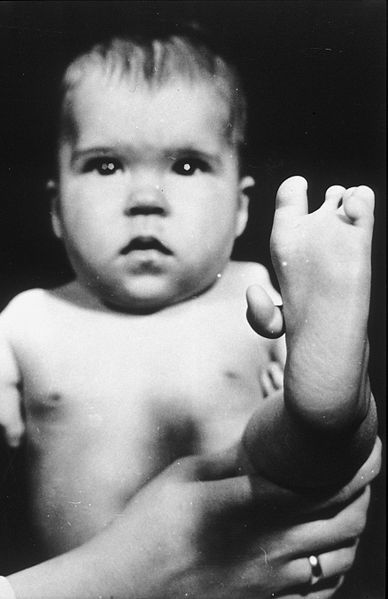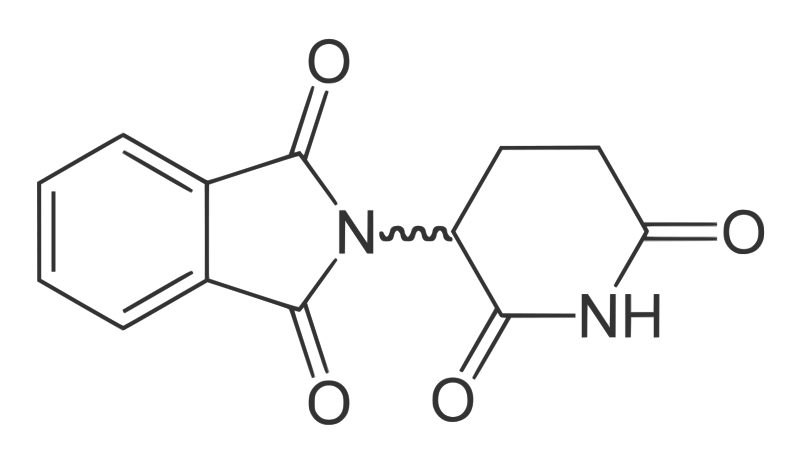Making Thalidomide Safe
Interview with
It's 50 years this year since the drug thalidomide was withdrawn from sale after it was linked to birth defects in the babies of pregnant women who used it. However it remains a very effective therapy for a range of diseases including cancers, myeloma, leprosy, and even HIV. This is why Neil Vargesson has been trying to find out how it works in order to produce a safer form of it...
Neil - We're particularly interested right now in thalidomide and how thalidomide, a drug given to pregnant ladies in the '50s and '60s to treat morning sickness, caused birth defects. Our group has identified one of the mechanisms by which it does. The drug is affecting blood vessels in the early embryo and prevents them from forming. This causes the loss of the tissue, so the limb doesn't form. Now, we're trying to identify what is the actual molecular target in the embryo that this drug is working on. We're also trying to make forms of the drug that don't cause birth defects but can still be used to treat patients. At the moment it's used around the world to treat leprosy, multiple myeloma and it's in trial for HIV, and cancers. So it's a quite useful drug but it has this dark side to it as well.
Chris - If it affects blood vessels, why just the limbs? 
Neil - It's a good question and that's a question we struggle to answer as well. It turns out that the limb are one of the last major tissues in the body to form. And at the time that morning sickness affects ladies, that's when the limb is forming the most. It's the most rapidly growing tissue. So the other organs can be affected and they are affected, but the limb is the most affected because it's being formed at the time when the drug would be taken by the ladies. It turns out that the blood vessels in the limb are quite unique in that they are very immature and susceptible to being broken down. This means the drug is affecting them and that's why the limb is always targeted. We're trying to find out what is the gene that's being affected in those cells. Why is it being affected? How is it affected? And can we stop it from being affected in the future?
Chris - The other conditions you mentioned - leprosy, HIV, multiple myeloma - Is it a similar mechanism at play there or is the drug working in a distinct way to treat those conditions then?
Neil - Thalidomide is a unique drug. It has many different actions. It has actions on blood vessels, it has actions on your inflammatory system, it has actions on the immune system. So the actions on leprosy is affecting the inflammatory system and that will be different to the effect on blood vessels. We don't know what the targets in the inflammatory system are specifically, but we do know that if you affect blood vessels in an embryo, you're going to get some sort of birth defect. We're trying to make a form of the drug that can't do that but can be used to still treat leprosy. Whether we can then make a form of the drug that you can use for cancer which doesn't cause these things, we don't know yet, but that's the essence of what we're trying to do.
Chris - It sounds trivial. We're trying a version of the drug that just won't do that, but how do you actually approach that? If it was trivial, people would have done it, so it's obviously quite a big problem?
Neil - Yeah. Well, it's taken 60 years to find out how the drug worked. We have to make new forms of the drug so the drug is quite complex. What you do pharmacologically is make new versions and then you test each version and you find one that does what you want it to do. However because we know that the drug is causing a defect affecting blood vessels, we already know we can eradicate those from our screens and just try the other forms. Hopefully one or several of these will give us versions that you can use.
Chris - Where have you got to?
Neil - We're at the stage where we're screening various compounds right now. So, I would hope that we'd have some candidates soon. Now I've said that, I've just probably just jinxed myself for the next 5 years, but hopefully soon.
Chris - Obviously, you can't do this in humans. So how are you measuring the outcomes or the impacts of the drug on development?
 Neil - So we use a range of systems. We use embryos. So we use chicken and fish embryos, we also use mouse cultures, and we use human cell lines. These give us all information we require to test the drug. If we do get compounds that we believe could be used in humans then there would be clinical trials and the whole process will have to occur to make sure it's safe in humans and that sort of thing. However we'd never advocate that these drugs should be ever be taken again during pregnancy. No drugs should be taken during pregnancy. The idea is that if there are people in Africa and South America right now that have leprosy, and they take the drug by mistake when they are pregnant, the chance of having a child with a birth defect are - we hope - lessened.
Neil - So we use a range of systems. We use embryos. So we use chicken and fish embryos, we also use mouse cultures, and we use human cell lines. These give us all information we require to test the drug. If we do get compounds that we believe could be used in humans then there would be clinical trials and the whole process will have to occur to make sure it's safe in humans and that sort of thing. However we'd never advocate that these drugs should be ever be taken again during pregnancy. No drugs should be taken during pregnancy. The idea is that if there are people in Africa and South America right now that have leprosy, and they take the drug by mistake when they are pregnant, the chance of having a child with a birth defect are - we hope - lessened.
Chris - This is a really tough one, isn't it? Once bitten, twice shy, and if you come back with a version of thalidomide that is very effective but still carries risk, even though it may be a very tiny one, we just can't afford to make that mistake can we?
Neil - No, not at all and I think that the fact we've got kids being born around the world today with those problems highlights the issue. We have to address this and if we're going to still use thalidomide for its clinical reasons, make sure it's as safe as it possibly can be. So yes, it's a tough question but the drug clinically is very effective for leprosy and multiple myeloma. The evidence is that for multiple myeloma, it prolongs life by 18 months. No other drug I'm aware of can do quite that job so there are pros and cons. At the moment, we're going down the road of, well if the drug is being used, let's try and make it as safe as possible.
Chris - And the other benefit of course is that they say nature reveals her workings through her mistakes. We presumably have learned an enormous amount about how normal processes work when it goes wrong when thalidomide is present.
Neil - Thalidomide, when the disaster occurred between 1958 and 1962, changed the way we did everything about drugs. For example we didn't realise there were differences between how the drugs acted on different animal models. We didn't know how to really test drugs properly and that opened up the whole field of toxicology. Since then yes, we know so much more about drugs. How they act, why they act and which cell types they affect as well as some of the signalling pathways. So, it kind of changed the world. It's a horrible thing to have happened but it did change the world.









Comments
Add a comment